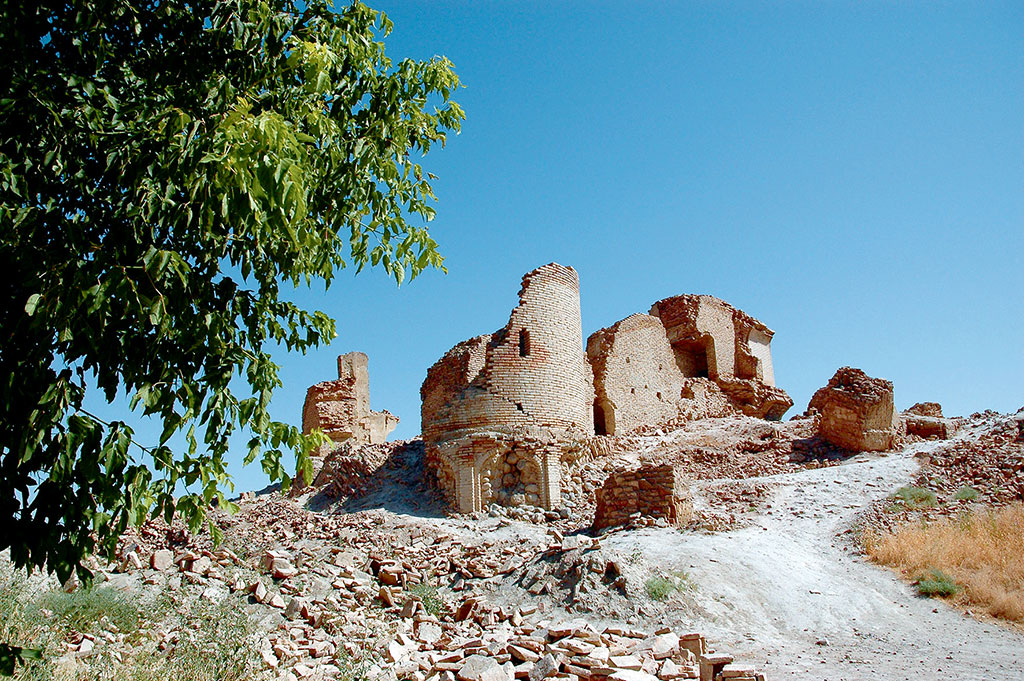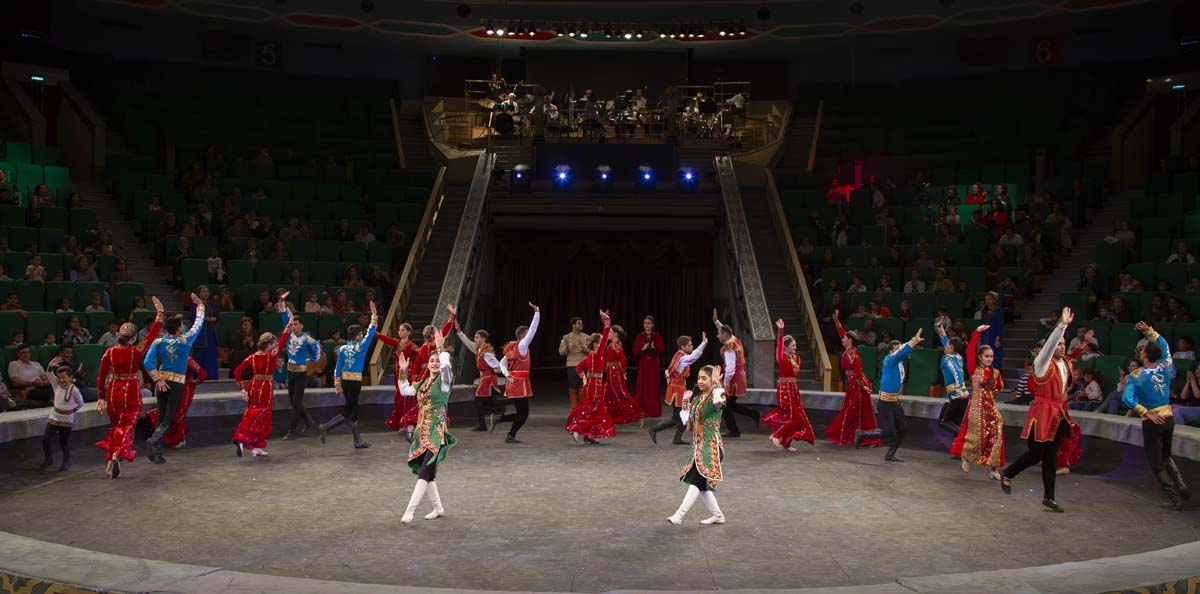Majestic ruins of Seyit Jamal Ad-Din rests few kilometres away east of Ashgabat, next to modern Anau, the administrative centre of Ahal velayat.
Years ago, there was a complex consisting of four buildings – the mosque, the building on top of the grave in front of the mosque and two large buildings with high domed halls.
Day after day throughout several centuries, it has been ruined by the time and the earthquake in 1948 destroyed it completely having left only the ruins. Majestic religious facility has been and remains the place of pilgrimage and attracts the attention of the tourists and researches.
The signs of the main façade of the mosque, which mention the name of Khorasan Ruler Abul Kasym babur (1446 – 1457) says: “This construction was built during the reign of the sultan the Great, the lord of his nations, the shelter of countries and the age of Abul Kasym Babur Bahadurkhan, let the Almighty immortalize his power and his reign”. Other signs say that the House of Beauty was built by somebody called Muhammed on his own money in 1455 – 1456 as a tribute to his father. This was vizier Muhammed Hudaydot, who chose the place for construction next to the grave of his father Jamal Ad Din, the native of Anau.
The mosque built from fired bricks overlooked the parade yard with wide lancet arch in high portal. There was a square hall 10.5 in length behind crowned by elliptic dome. The portal faced the north and there was mehrab decorated with carvings deep inside the premise in the thickness of the south wall. East and west groups of facilities surrounded spacious yard in front of the portal of the mosque, their upper halls (7 m in diameter) on two floors were surrounded by small rooms. Two double-level minarets were located at the northern façade of the mosque and seemed to extend the side piers of the portal.
Mosaic decoration of the portal with the image of two ajdarkha dragons facing each other presented the highest value. Their yellow bodies coiled on dark-blue mosaic background with small floral pattern, which started from grinned jaws of each fantastic creature. Such decoration on the façade of religious facility in the Central Asia is quite unique. Today, its fragments are kept in the Museum of Visual Arts.
Comprehensive explanation of the origin of this pattern on the portal of Anau Mosque has not been found yet. Archaeologists, culture and arts experts are familiar with use of dragons in design, which origins go far behind in the history of Oriental arts but these are artistic traditions of Turkmen people, which are obviously traced in decoration of Anau Mosque.
There is a legend about the origin of Seyit Jamal Ad Din mosque. In the times of the reign of fair and wise queen Jemal, the pillar with large bell was installed at the stronghold wall. Every traveller who needed help could ring the bell and get it. Once, the citizens heard anxious ringing. Having arrived to the city gates, they saw huge ajdarkha dragon was ringing the bell. At the same time he pointed either toward the mountains or to two craftsmen with axes and saws. Wise queen has ordered the craftsmen follow the dragon who left for the mountains. Upon coming to the mountains, they saw another dragon writhing with horrible pain. The dragon swallowed large markhor and the horns were stuck in dragon’s throat. Brave craftsmen entered open mouth of the creature and cut the horns, having saved the dragon from the torment. Then, the first dragon brought the craftsmen to the cave full of treasury and let them take as much of it as they could carry. Next day early in the morning, the citizens were woken up the ring of the bell again. When they opened the gates they saw two dragons, which brought the treasury as a gratitude for their salvation. Having put the gold and precious stones at the feet of the queen, the dragons left for the mountains. Wise ruler ordered to build large mosque for this means and to portray two dragons who gave these countless riches on its portal. Probably, their images served as talismans for the citizens but for us they remains a mystery…
Years ago, there was a complex consisting of four buildings – the mosque, the building on top of the grave in front of the mosque and two large buildings with high domed halls.
Day after day throughout several centuries, it has been ruined by the time and the earthquake in 1948 destroyed it completely having left only the ruins. Majestic religious facility has been and remains the place of pilgrimage and attracts the attention of the tourists and researches.
The signs of the main façade of the mosque, which mention the name of Khorasan Ruler Abul Kasym babur (1446 – 1457) says: “This construction was built during the reign of the sultan the Great, the lord of his nations, the shelter of countries and the age of Abul Kasym Babur Bahadurkhan, let the Almighty immortalize his power and his reign”. Other signs say that the House of Beauty was built by somebody called Muhammed on his own money in 1455 – 1456 as a tribute to his father. This was vizier Muhammed Hudaydot, who chose the place for construction next to the grave of his father Jamal Ad Din, the native of Anau.
The mosque built from fired bricks overlooked the parade yard with wide lancet arch in high portal. There was a square hall 10.5 in length behind crowned by elliptic dome. The portal faced the north and there was mehrab decorated with carvings deep inside the premise in the thickness of the south wall. East and west groups of facilities surrounded spacious yard in front of the portal of the mosque, their upper halls (7 m in diameter) on two floors were surrounded by small rooms. Two double-level minarets were located at the northern façade of the mosque and seemed to extend the side piers of the portal.
Mosaic decoration of the portal with the image of two ajdarkha dragons facing each other presented the highest value. Their yellow bodies coiled on dark-blue mosaic background with small floral pattern, which started from grinned jaws of each fantastic creature. Such decoration on the façade of religious facility in the Central Asia is quite unique. Today, its fragments are kept in the Museum of Visual Arts.
Comprehensive explanation of the origin of this pattern on the portal of Anau Mosque has not been found yet. Archaeologists, culture and arts experts are familiar with use of dragons in design, which origins go far behind in the history of Oriental arts but these are artistic traditions of Turkmen people, which are obviously traced in decoration of Anau Mosque.
There is a legend about the origin of Seyit Jamal Ad Din mosque. In the times of the reign of fair and wise queen Jemal, the pillar with large bell was installed at the stronghold wall. Every traveller who needed help could ring the bell and get it. Once, the citizens heard anxious ringing. Having arrived to the city gates, they saw huge ajdarkha dragon was ringing the bell. At the same time he pointed either toward the mountains or to two craftsmen with axes and saws. Wise queen has ordered the craftsmen follow the dragon who left for the mountains. Upon coming to the mountains, they saw another dragon writhing with horrible pain. The dragon swallowed large markhor and the horns were stuck in dragon’s throat. Brave craftsmen entered open mouth of the creature and cut the horns, having saved the dragon from the torment. Then, the first dragon brought the craftsmen to the cave full of treasury and let them take as much of it as they could carry. Next day early in the morning, the citizens were woken up the ring of the bell again. When they opened the gates they saw two dragons, which brought the treasury as a gratitude for their salvation. Having put the gold and precious stones at the feet of the queen, the dragons left for the mountains. Wise ruler ordered to build large mosque for this means and to portray two dragons who gave these countless riches on its portal. Probably, their images served as talismans for the citizens but for us they remains a mystery…







